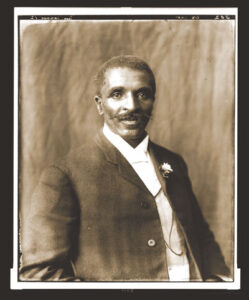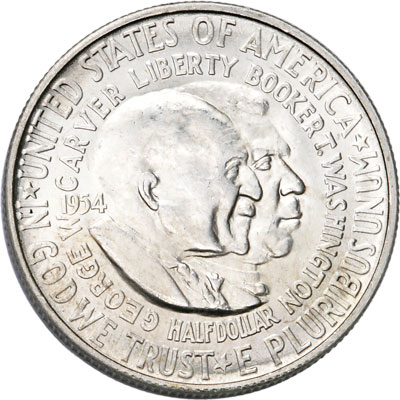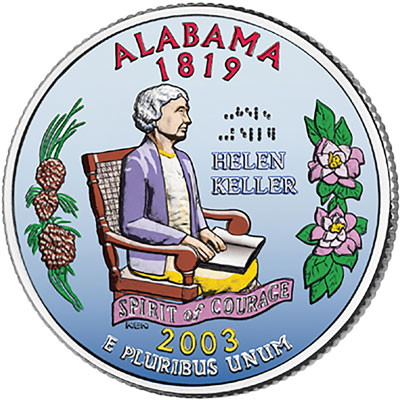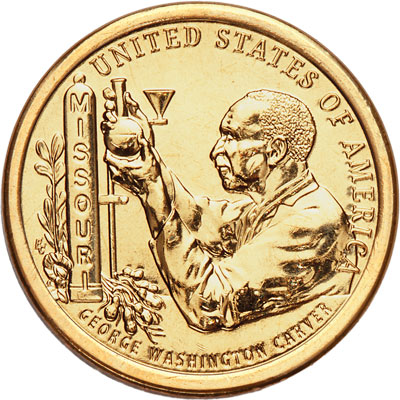George Washington Carver… The Plant Doctor
What do pancake flour, hand lotion and rubber all have in common? Dr. George Washington Carver – Missouri’s own agricultural scientist and horticulturist – improved them with the use of peanuts. Born enslaved towards the end of the Civil War, Carver would go on to not only receive an education, but also become an educator at Alabama’s Tuskegee Institute for 47 years.
Working alongside men like Booker T. Washington, Carver was an advocate of poor southern farmers. The South, having been routinely farmed for decades by the time of Carver’s birth in 1864, struggled to produce healthy crops. Over the course of his career, Carver assisted farms with the implementation of crop rotation as well as help revolutionize the underused peanut plant.
Celebrating a lifetime dedicated to helping underprivileged farmers, the final 2024 Innovation dollars showcase the life and work of George Washington Carver.
Carver’s Green Thumb
Encouraged throughout childhood to learn about the world around him, at 11 years old George Washington Carver – nicknamed “the plant doctor” by local farmers – eagerly left Diamond, MO. As a teenager, he would travel from town to town in search of an education. Originally Carver was interested in pursuing a degree for art and music at Iowa State Agricultural College. However, urged by Professor Etta Budd to study botany, he would go on to get both his bachelor’s and master’s degrees in agricultural science.
By the time he began working for the Tuskegee Institute (now Tuskegee University) in 1896, Carver would be the first African American with an advanced degree in scientific agriculture.
Over the course of his career at the vocational school, Carver served as both a distinguished professor and researcher. Here he would invent the Jesup Agricultural Wagon – the first mobile school of its kind. Used to travel across rural Alabama, Carver would use his invention to teach farmers about the benefits of crop rotation. Executed by planting different crops on a piece of land each season – including the peanut – farmers saw their harvests and soil’s health improve.
As Carver worked alongside farmers, he began to unlock the secrets of the peanut plant.
Nuts about Peanuts
Originally from South America, the peanut has played a culturally significant role for thousands of years. Used as an inspiration for pottery as well as offerings to Incan gods like Inti or Viracocha, the Indigenous Peoples of South America valued the peanut plant. At the turn of the 16th century, the Spanish traveling in search of far off lands would relocate the versatile plant to Europe.
Having crossed the Atlantic Ocean to reach the distant shores of Asia and Africa, the plant would once again make its way across the world. This time it would be Africans who brought the peanut plant to North America in the 1700s.
Nearly a century later, the peanut would gain noteriety during the Civil War. Towards the end of the war, rations had dwindled considerably and soldiers made do with what little food was available. At the top of the list was the hearty peanut. Easy to carry and full of protein, the peanut became a popular food source among the soldiers.
Years later – thanks to the work of Missouri’s own Dr. George Washington Carver – these delectable snacks would become a crucial resource in hundreds of products.
The Peanut Man

Years of cotton farming across the South had sapped vital nutrients from the soil. Looking for ways to reintroduce the much-needed nitrogen, Carver put forward the peanut. Up until this point, peanuts had remained a relatively untouched opportunity for farmers and research alike.
Skeptical at first, farmers had begun to implement the plant into their crops. Within a few years, the South had an explosion of workable soil – and peanuts – on their hands once again.
Carver, dedicated to improving the lives of African Americans, began looking at alternative uses for the peanut. By studying the adaptable plant, he hoped to do several things: encourage farmers to continue growing them, keep the soil full of nutrients for future growing seasons and use the plant as a food resource.
Over the course of his research, Carver would come up with more than 300 innovations for the peanut. In honor of his work with the legume, Missouri’s 2024 Innovation dollars place George Washington Carver and the peanut plant front and center.
Supported by men like inventor Thomas Edison, industrialist Henry Ford and President Franklin D. Roosevelt, Carver would publish bulletins and give speeches – including being one of the first African Americans to address Congress – touting the importance of the plant. His passion surrounding the peanut and all it could accomplish was contagious. In recognition of his work, Carver was awarded the NAACP Spingarn Medal, Theodore Roosevelt Medal and more throughout his lifetime.
“All mankind are beneficiaries of his discoveries in the field of agricultural chemistry. The things which he achieved in the face of early handicaps, will for all time, afford an inspiring example to youth everywhere,” President Roosevelt said upon Carver’s death in January of 1943.
Rounding out the Year
The 2024 Innovation dollars have seen a variety of accomplishments: from John Lane’s steel plow in Illinois, Alabama’s Saturn V rocket to Maine’s own Dr. Bernard Lown and now Missouri’s Dr. George Washington Carver. These four dollars celebrate inventions and doctors that have changed the course of American history.
Introduced to the public with George Washington’s Signature in 2018, the U.S. Innovation dollars have become a popular series. With 8 years left in the series and 32 coins yet to be minted, novice and experienced collectors alike eagerly await each year’s new releases. Next year’s Innovation dollars featuring Arkansas, Michigan, Florida and Texas, promise to be just as exciting as 2024’s. Which dollar has been your favorite this year? What upcoming coin are you looking forward to? Tell me in the comments below!
Sources:
Missouri Dept. of Agriculture “George Washington Carver” Accessed August 26, 2024 https://agriculture.mo.gov/gwc.php
Science History Institute Museum & Library. “George Washington Carver” Accessed August 27, 2024 https://www.sciencehistory.org/education/scientific-biographies/george-washington-carver/
National Peanut Board. “George Washington Carver: A World-Famous Scientist, Inventor and Educator” Accessed August 26, 2024 https://nationalpeanutboard.org/news/george-washington-carver
National Peanut Board. “History of Peanuts & Peanut Butter” Accessed August 27, 2024 https://nationalpeanutboard.org/news/history-peanuts-peanut-butter
Iowa State University. “George Washington Carver” Accessed September 4, 2024 https://collab.cals.iastate.edu/george-washington-carver






